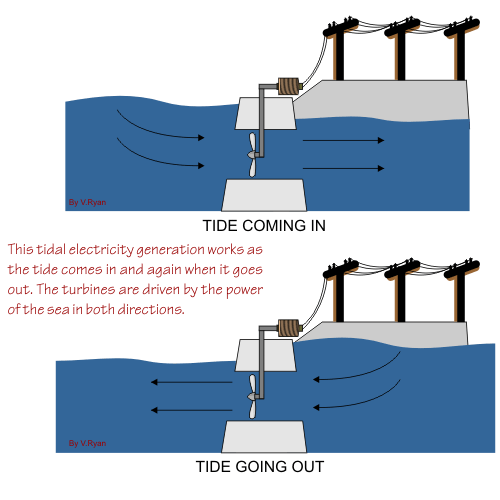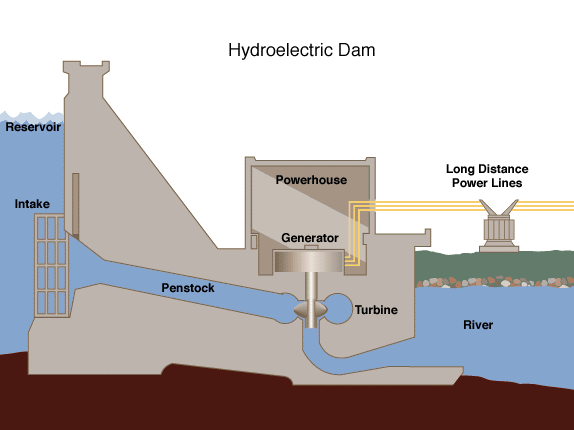
Courtesy of: http://www.mywindpowersystem.com/wp-content
/uploads/2009/08/renewable-energy-tidal-2.gif

Courtesy of: http://www.mywindpowersystem.com/wp-content
/uploads/2009/08/renewable-energy-tidal-2.gif
Tidal & Wave PowerOne resource we can use, which is not immediately apparent to some, is the ocean. However, the ocean has the potential to give us more than enough power to run all of our appliances for eons to come as long as the moon's gravitational pull on our planet does disappear. Thanks to our "satellite", the Moon, the oceans go through daily tides which go from being at a daily high to a daily low, and in doing so we can harness this change in water height to run turbines. If you remember from the previous web page, a generator is simply a conducting coil of wire that spins in a magnetic field which induces a current in the wires. This changes in tide can be used to spin turbines, which are connected to generators to actually take the mechanical energy of the Moon's gravity on our planet's oceans to create electrical energy! How much energy you may be wondering to yourself? A LOT! In a study done in 2003, the European Thematic Network on Wave Energy predicted there could be as much as 150-750 TW of economically recoverable power to be gained once the technology to better capture this power was available (8). That is a lot of power! Considering we often speak in kW or kilowatts when discussing power, a terawatt is one million kilowatts making this a huge source of power!Tidal power is not the only contributing source for that factor though. This also takes into account wave action that could be used to run generators. This is not a new concept either, as several places around the world (near large bodies of water) have used underwater fan blades to spin the coils in a generator. This is very similar to wind energy as waves are less predictable than tides, and in many cases will spin the blades so slowly that if there were no gearbox to increase the internal speed of the coils, the induced current would be negligable. While this technology is stunning for coastal areas, for those of us stuck in the middle of a large state with the nearest ocean being several hundred miles away, it would likely not be economical to transport that amount of power up to us. Does this mean that folks like us are unable to harness the power of water? |

Courtesy of: http://www.virtualmuseum.ca/Exhibitions/Hydro/_img/
resources/Dam_Illustration.gif
Hydroelectric DamsWhile many places on the Earth are distant from any ocean, many are near running water in the form of rivers, creeks, and glacial runoff. This form of water movement can also be used to power our homes and electronics, by using the force of gravity to again move turbines. In a hydroelectric dam, water is held back by the dam in an elevated reservoir which is much higher in altitude than that of the water that makes it through the dam. The water from the reservoir rushes through the water intake into penstocks, or large tubes for carrying water down to the turbines (7). As with the rest of the turbines we have discussed, these are connected to a generator which spins conducting wires in a magnetic field to create induced current. What I find more amazing is the propensity we have with using all these different forms of force to perform the same task! Dams are certainly not a new idea, as some dams have been around for decades or more, such as the Hoover Dam, which has been used to gather power for Nevada, California, and Arizona since 1936 (3). This form of power generation can also be very powerful, which Hoover Dam is a good example of. Hoover Dam alone generates roughly 2080 megawatts of power which is more or less evenly distributed to the three states to be used (3). The great thing about this power is that it is self-replenishing, in that as the cycle of rain fall refills the used water from the reservoir, it is again at a higher gravitational potential and can be used all over again to power the dam. Nothing is lost or destroyed in this process unlike when using fossil fuels to create steam to turn a power plant's generators. |